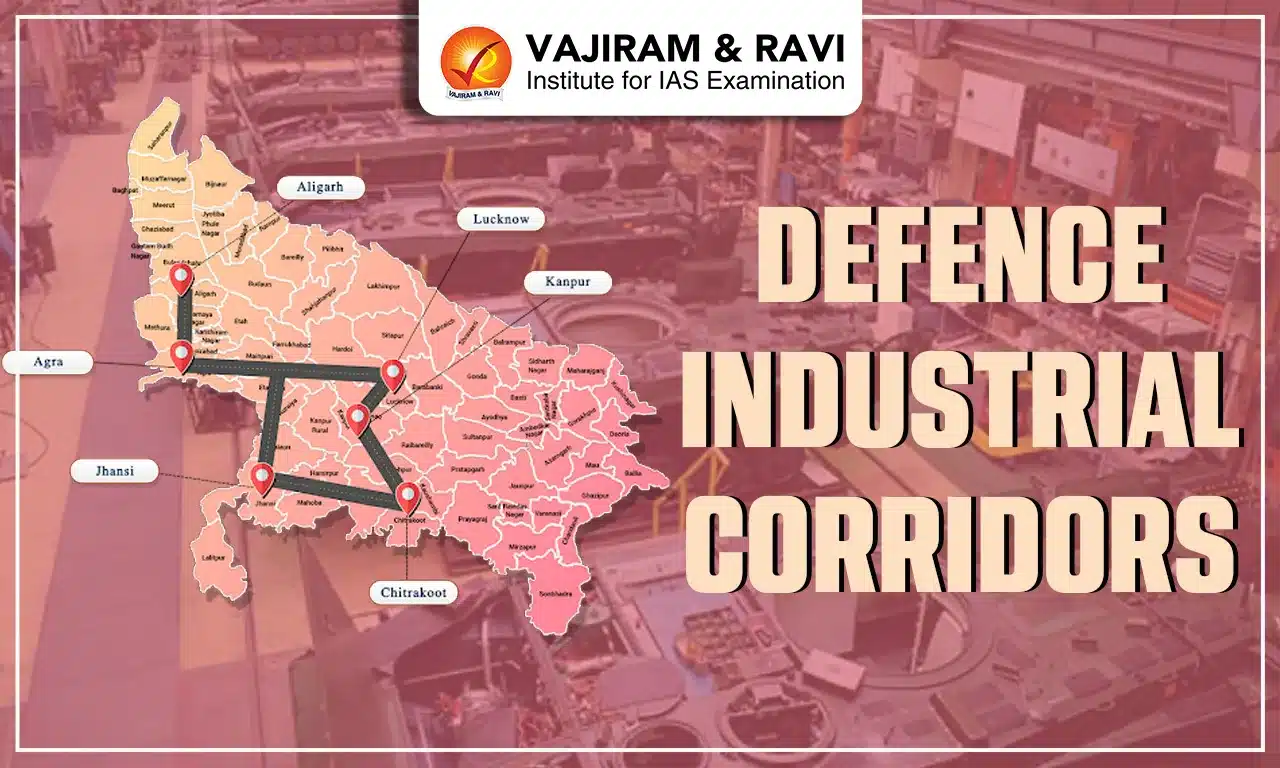The Defence Industrial Corridor is a dedicated region or area strategically planned to promote indigenous production of defence and aerospace-related items. Since India is one of the key Defence markets driven by increasing spending, the capital expenditure for Defence procurement is expected to be around USD200-250 billion over the next 10 years, and 'Make in India' has been the government's cornerstone to promote indigenous Defence production in the country.
Given the increasing focus on self-reliance, the Ministry of Defence (MoD), has set a target of doubling the Defence production to USD 25 billion by 2025 from USD 12.5 billion in 2019-20. In order to achieve the targeted annual growth rate of around 15 percent, the MoD is focusing on boosting Defence exports through these corridors.
Objectives of Defence Industrial Corridors
The establishment of Defence Industrial Corridors in India marks a significant milestone in the country's defence manufacturing capabilities with the following objectives:
- Economic growth of States: Transform armed service requirements to drive the economic growth of the states and the region associated with the states of UP and TN.
- Fulfilling Indigenisation requirements: Capture indigenisation requirements set by the Ministry of Defence from DPUs and OFBs towards supporting defence manufacturing infrastructure in the country.
- Indigenisation of Defence Manufacturing: Promote indigenisation and support “Make in India” towards fulfilling equipment requirements worth over 250 billion dollars by 2025.
- Development of MSMEs: Promote Ancillarisation (outsources) and development of MSMEs for Aerospace and Defence manufacturing in each of the nodes of the states.
- The ‘Make in India’ initiative aims to achieve 70% indigenisation of the defence sector.
- Employment and Skill Development: Encourage skill development and create jobs within the state by meeting skill/education standards espoused by the A&D sector globally.
UP Defence Industrial Corridor
The UP Defence Industrial Corridor, under the Uttar Pradesh Expressways Industrial Development Authority (UPEIDA), encompasses six strategically vital nodal points: Agra, Aligarh, Chitrakoot, Jhansi, Kanpur, and Lucknow. This corridor offers "Plug and Play" support consisting of the following features:
- Amenities: Assured water supply and uninterrupted electricity (132 KVA) with pelican wire fencing boundary wall at the site.
- Connectivity: Connectivity with a 4-lane heavy-duty highway linked to Bundelkhand Expressway and Delhi-Jhansi route.
- Single Window Clearances: Single Window approvals and clearances for Defence and Aerospace (D&A) manufacturing units through Nivesh Mitra, the state's single window system.
- Flexible Working Conditions: Labour permits tailored for the Depreciation and Amortization (D&A) industry to allow flexible employment conditions.
- Simplification of Procedures: Simple procedures and a streamlined regulatory regime, ensure easy reimbursement of incentives and subsidies.
TN Defence Industrial Corridor
The Tamil Nadu Defence Corridor, initiated by the Government of Tamil Nadu, comprises five pivotal nodes: Chennai, Coimbatore, Hosur, Salem, and Tiruchirappalli. Tamil Nadu has strategic advantages which lead to the following features of this corridor:
- Airports: The are four international airports (Chennai, Coimbatore, Trichy, Madurai) and two domestic airports (Tuticorin, Salem).
- Power Supply: Tamil Nadu is a power surplus state with a renewable energy capacity of 11,113 MW.
- Chennai’s connectivity: The capital of Tamil Nadu, Chennai, is connected globally by three submarine cables, providing a bandwidth of 14.8 Tbps.
- South-Korean Investments: TN is a preferred destination for Korean investors as the state is the largest recipient of Korean Foreign Direct Investment (FDI) in India.
Challenges to the Defence Industrial Corridors
The implementation of Defence Industrial Corridors in India, though promising, is not without its challenges.
- Regional Imbalance: Since, only TN and UP have been chosen for the development of these corridors, other states might feel marginalised.
- This can lead to political challenges and demands for additional DICs in different states.
- Private Sector Engagement: While DICs aim to attract private sector investment, there may be challenges in getting private industries to commit their resources towards defence industrialization.
- Private players are sceptical and this requires the government to put sustained efforts to incentivize and encourage participation.
- Tax benefits to the Industries: Apart from the single window clearances and cluster approach of the defence industrial corridors, the industries especially the private sector players would seek various tax rebates and exemptions which the government provides Special Economic Zones(SEZs).
- Incorporation of MSMEs in Global Supply Chains: The incorporation of MSMEs in the global supply chain is very challenging since the Indian MSMEs are at a very nascent stage of development, especially, in the Defence sector.
- The competition with the global players and the advanced technologies like advanced electronics and materials along with skilled manpower such as mechatronics (mechanical plus electronics engineer),will be challenging.
- Ensuring Quality and Standards: The products manufactured within the DICs must meet stringent global standards to be competitive in the international market.
- Also, a skilled workforce is required to ensure the quality standard of the products.
- Logistical Hurdles: The logistical challenges that need to be addressed, such as transportation, supply chain management, and infrastructure development, are essential for the efficient functioning of the corridors.
- The National Logistics Policy(2022) can help reduce these hurdles.
- Industry-Academia Collaboration: There is a need to strengthen collaboration between the defence industry and academic institutions is crucial for research, innovation, and skill development.
Steps to be taken in the Future
Following are the steps required to be taken in future to make such projects a success and streamline the infrastructure-building process:
- Continuous Policy Evolution: There is a need to implement ongoing policy reforms to create a conducive environment for growth and innovation in the defence sector.
- For example, the National Infrastructure Pipeline
- Private Sector Engagement: There is a need to actively involve the private sector to bring in expertise, investment, and innovation crucial for success.
- This can be achieved by providing them with incentives and recognising their involvement.
- Foster Strong Partnerships: Encourage robust collaboration between the government and private entities to drive innovation, share resources, and collectively solve challenges.
- Invest in Research and Development: Prioritise R&D efforts to develop cutting-edge technologies, enhancing India's competitiveness in the global defence market.
- Adapting to Industry 4.0 standards: In the defence sector, it would involve incorporating advanced technologies like artificial intelligence, Internet of Things (IoT), big data analytics, and automation into the manufacturing and operational processes.
- For example, 3D Printing facilitates the use of additive manufacturing for rapid prototyping and even the production of spare parts.
Last updated on January, 2026
→ Check out the latest UPSC Syllabus 2026 here.
→ Join Vajiram & Ravi’s Interview Guidance Programme for expert help to crack your final UPSC stage.
→ UPSC Mains Result 2025 is now out.
→ UPSC Notification 2026 is scheduled to be released on January 14, 2026.
→ UPSC Calendar 2026 has been released.
→ UPSC Prelims 2026 will be conducted on 24th May, 2026 & UPSC Mains 2026 will be conducted on 21st August 2026.
→ The UPSC Selection Process is of 3 stages-Prelims, Mains and Interview.
→ Prepare effectively with Vajiram & Ravi’s UPSC Prelims Test Series 2026 featuring full-length mock tests, detailed solutions, and performance analysis.
→ Enroll in Vajiram & Ravi’s UPSC Mains Test Series 2026 for structured answer writing practice, expert evaluation, and exam-oriented feedback.
→ Join Vajiram & Ravi’s Best UPSC Mentorship Program for personalized guidance, strategy planning, and one-to-one support from experienced mentors.
→ UPSC Result 2024 is released with latest UPSC Marksheet 2024. Check Now!
→ UPSC Toppers List 2024 is released now. Shakti Dubey is UPSC AIR 1 2024 Topper.
→ Also check Best UPSC Coaching in India



















